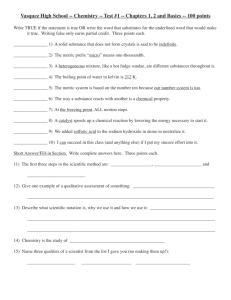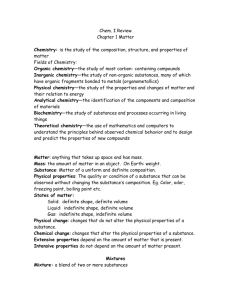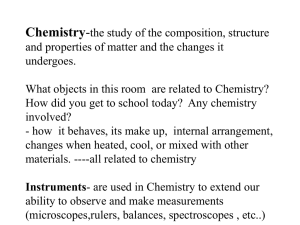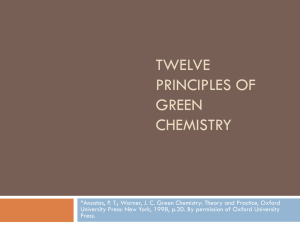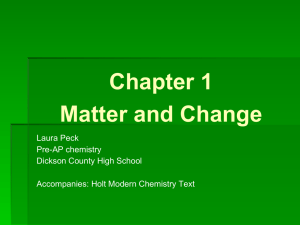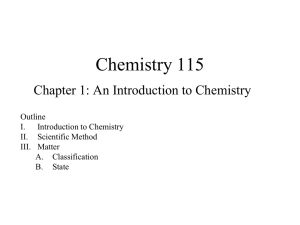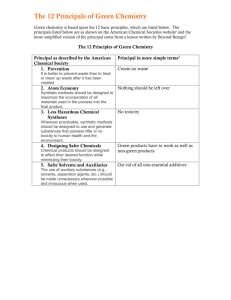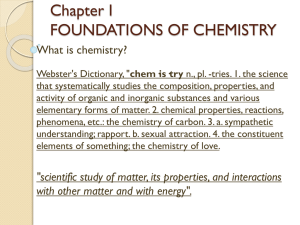Chapter 1 Outline Notes
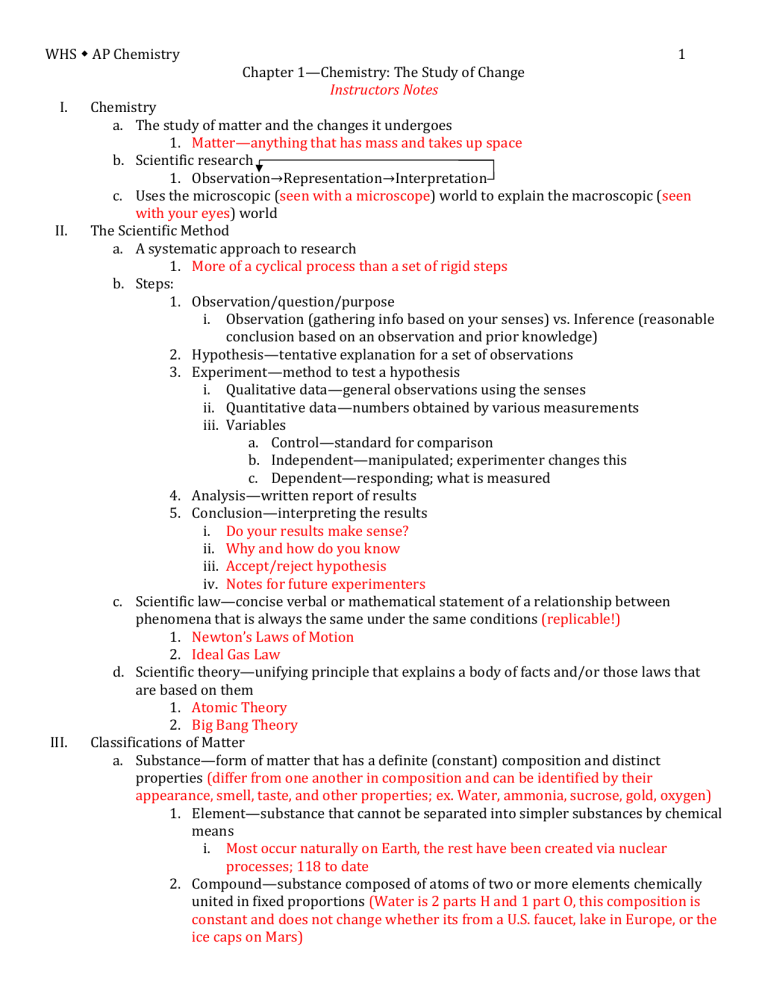
WHS AP Chemistry
Chapter 1—Chemistry: The Study of Change
Instructors Notes
I.
Chemistry a.
The study of matter and the changes it undergoes
1.
Matter—anything that has mass and takes up space b.
Scientific research
1
1.
Observation → Representation → Interpretation c.
Uses the microscopic ( seen with a microscope ) world to explain the macroscopic ( seen with your eyes ) world
II.
The Scientific Method a.
A systematic approach to research
1.
More of a cyclical process than a set of rigid steps b.
Steps:
1.
Observation/question/purpose i.
Observation (gathering info based on your senses) vs. Inference (reasonable conclusion based on an observation and prior knowledge)
2.
Hypothesis—tentative explanation for a set of observations
3.
Experiment—method to test a hypothesis i.
Qualitative data—general observations using the senses ii.
Quantitative data—numbers obtained by various measurements iii.
Variables a.
Control—standard for comparison b.
Independent—manipulated; experimenter changes this c.
Dependent—responding; what is measured
4.
Analysis—written report of results
5.
Conclusion—interpreting the results i.
Do your results make sense? ii.
Why and how do you know iii.
Accept/reject hypothesis iv.
Notes for future experimenters c.
Scientific law—concise verbal or mathematical statement of a relationship between phenomena that is always the same under the same conditions (replicable!)
1.
Newton’s Laws of Motion
2.
Ideal Gas Law d.
Scientific theory—unifying principle that explains a body of facts and/or those laws that are based on them
1.
Atomic Theory
2.
Big Bang Theory
III.
Classifications of Matter a.
Substance—form of matter that has a definite (constant) composition and distinct properties (differ from one another in composition and can be identified by their appearance, smell, taste, and other properties; ex. Water, ammonia, sucrose, gold, oxygen)
1.
Element—substance that cannot be separated into simpler substances by chemical means i.
Most occur naturally on Earth, the rest have been created via nuclear processes; 118 to date
2.
Compound—substance composed of atoms of two or more elements chemically united in fixed proportions (Water is 2 parts H and 1 part O, this composition is constant and does not change whether its from a U.S. faucet, lake in Europe, or the ice caps on Mars)
WHS AP Chemistry i.
Has properties different than that of its components a.
2 H
2
+ O
2 → 2 H
2
O b.
Na + Cl → NaCl
2 ii.
Can be separated only by chemical means into their pure components a.
Electrolysis of water b.
Mixture—combination of two or more substances in which the substances retain their distinct identities; do not have fixed proportions (ex. Air samples differ depending on aspects of location; altitude, population, etc.) ; can be created and separated by physical means into pure compounds without changing the identities of the components (ex. sugar water; techniques: distillation, filtration, chromatography)
1.
Homogeneous—the composition of the mixture is the same throughout, also called a solution i.
Mixed at the molecular level; different properties and components are not noticeable ii.
Ex. Metal alloys
2.
Heterogeneous—the composition of the mixture is not uniform i.
Properties vary throughout; different components visible ii.
Ex. Trail mix
IV.
States of Matter (differ in the distances between the molecules; can be interconverted by ±heat w/out changing the composition of the substance) a.
Solid—rigid shape, little volume change as temperature and pressure change (molecules are held close together in an orderly fashion with little freedom of motion) b.
Liquid—fixed volume, fluid in shape, takes the shape of the bottom of a container, welldefined surface (molecules are close together but not held so rigidly in position and can move past one another) c.
Gas—volume expands to fill container, volume varies according to temp. and pressure
(molecules are separated by distances that are large compared with the size of the molecule)
V.
Properties of Matter a.
Physical—can be measured and observed without changing the composition or identity of a substance (i.e. mass, volume, boiling temp, melting temp, conductivity, density, etc.) b.
Chemical—how a substance interacts with other substances (ability or inability, ex burns in air, forms gas with acid, reacts with oxygen) c.
Extensive—depends on how much matter is being considered (measured value depends on amount of matter; additive)
1.
Mass—the quantity of matter in a given sample of a substance
2.
Volume—length cubed d.
Intensive—does not depend on how much matter is being considered (not additive)
1.
Density —the mass of an object divided by its volume; D= 𝑚
𝑉
; usually dec. w/ temp
2.
Temperature
3.
Color
VI.
Changes in Matter a.
Physical—asters a substance without changing the composition
1.
Appearance, size, phase b.
Chemical—process in which a substance(s) is changed into one or more new substances
(chemical reaction)
1.
Combustion of gasoline, formation of gas or color
2.
Alters appearance and chemical makeup
3.
Enzymes in the body
WHS AP Chemistry
VII.
Measurement a.
Always written as a number with the appropriate unit!! b.
Different instruments enable us to measure a substances properties
3
1.
Mass
→
balance
2.
Volume → buret, pipet, graduated cylinder volumetric flask
3.
Temperature → thermometer c.
SI units—international system of units; made of prefixes and 7 base units (in your book on pg 13 table 1.2 and1.3) d.
Mass vs weight (scalar vs. vector; speed vs. velocity)
1.
Mass—the amount of matter in an object
2.
Weight—the force that gravity exerts on an object (depends on location) e.
Temperature scales
1.
Fahrenheit
2.
Celsius
3.
Kelvin (SI Unit)
4.
K= °C + 273
VIII.
Handling Numbers a.
Scientific notation —used to express really big or small numbers
1.
N× 10 𝑛 i.
N is the coefficient (1≤N>10) ii.
n is the exponent (± integer)
2.
Adding and subtracting whole number i.
Convert to same exponent ii.
Combine the coefficients iii.
Keep the same exponent
3.
Multiplying and dividing i.
Combine coefficients ii.
Add exponents (multiplication) or subtract exponents (division) b.
Accuracy vs. Precision
1.
Accuracy—how close to a measurement is to the true value of the quantity that was measured (measured by percent error)
2.
Precision—how close measurements are to each other (measured by sig. figs. or ± notation) c.
Significant figures —meaningful digits in a measured or calculated quantity (When in
doubt pick 3)
1.
Determining significant figures (rules on pg. 20 in book)
2.
Measured quantities i.
Reading error = 1/10 of the smallest division on the ruler
3.
Calculated quantities i.
Round only the last step to match the least precise number ii.
Addition and subtraction → number of places behind the decimal iii.
Multiplication and division
→
number of significant figures
IX.
Dimensional Analysis a.
Procedure used to convert between units b.
Given quantity × conversion factor = desired quantity
1.
Units should cancel (given unit × desired unit given unit
= desired unit)
